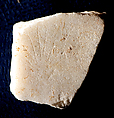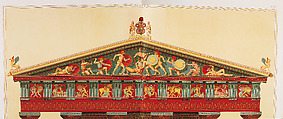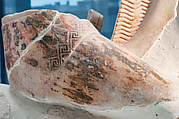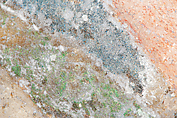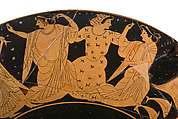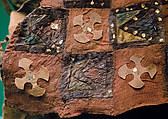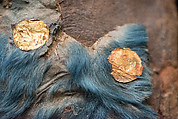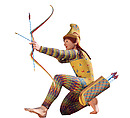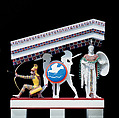Returned to lender The Met accepts temporary loans of art both for short-term exhibitions and for long-term display in its galleries.
Reconstruction of a marble archer in the costume of a horseman of the peoples to the north and east of Greece, from the west pediment of Temple of Aphaia, Variant C
Vinzenz Brinkmann German
Ulrike Koch-Brinkmann
Not on view
Vinzenz Brinkmann and Ulrike Koch-Brinkmann
2019
Original: Greece, Aegina, ca. 480 B.C., marble, Staatliche Antikensammlungen und Glyptothek, Munich, Inv. West XI
The archer from the west pediment of the Temple of Aphaia on Aegina, which presumably shows the Trojan war, wears long, tightly fitting trousers with a complex zig-zag pattern. Over his long-sleeved pullover with diamond pattern he wears a vest, which is decorated with a wide border and with small figures of griffin-birds and lions. This splendidly ornamented clothing of the famed horsemen of the northern and eastern neighbors of the Greeks is clearly visible with the help of ultraviolet and raking light. The locks of hair were fashioned separately and then attached. It has been proposed that this figure shows the Trojan prince Paris, who abducted Helen and thus caused the Trojan war. Paris eventually shot the arrow which killed the Greek warrior Achilles.
The excavators of the fragments of the pedimental sculptures of the temple of Aphaia at Aigina found many remnants of blue and red paint, but no pigment from the garment of the archer has survived. Paint rendering the skin (a mixture of madder and red ochre) can also be documented on several otherwarriors and therefore is assumed to have been used on all the figures of the west pediment.
For the reconstruction Variants A and B, the colors green (malachite), blue (azurite), and red, along with yellow and brown ocher, were chosen, on the analogy of the so-called Persian Rider
from the Athenian Acropolis. During the reconstruction process it became clear that the decorative elements were designed with the help of a grid. The two variants were differentiated by reversing the placement of blue and green, as well as red and brown ocher, within the decoration of the trousers
and the upper garments.
The reconstruction Variant C was not made using a cast of the figure as restored by Bertel Thorvaldsen like for Variant A and B, but rather a copy based on a 3-D scan of the original. In 3-D printing, which was done in PMMA, traces of the ornament that have weathered can be made out even in areas where they are not revealed by photography. This precise information served as the basis of the most recent reconstruction of the ornament and confirms the process used for Variants A and B. Individual elements of the zig-zag border that runs around the vest are a little wider in this variant.
The traces of pigment on the fragments still in the storerooms of the excavation at the sanctuary in Greece could be examined in 2017 using newer techniques of ultraviolet-visible absorption spectroscopy (UV-Vis spectroscopy) and visible-induced infrared luminescence imaging
(VIL), enabling a more precise identification. These new results led to a higher degree of precision in the new reconstruction of 2019. So, for example, it was determined that the blue pigment used was Egyptian blue and for red, red ocher mixed with cinnabar. In addition, on the analogy of ancient textiles of the peoples to the north who rode horses, now preserved in the State Hermitage Museum in St. Petersburg, dots of gilding were added to the ornament.
Due to rights restrictions, this image cannot be enlarged, viewed at full screen, or downloaded.
This artwork is meant to be viewed from right to left. Scroll left to view more.






